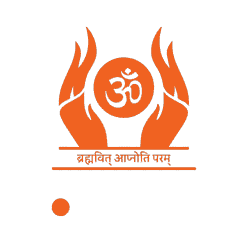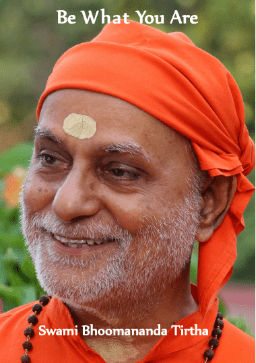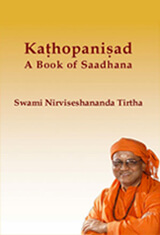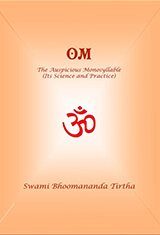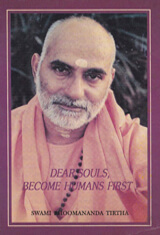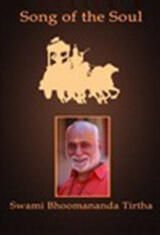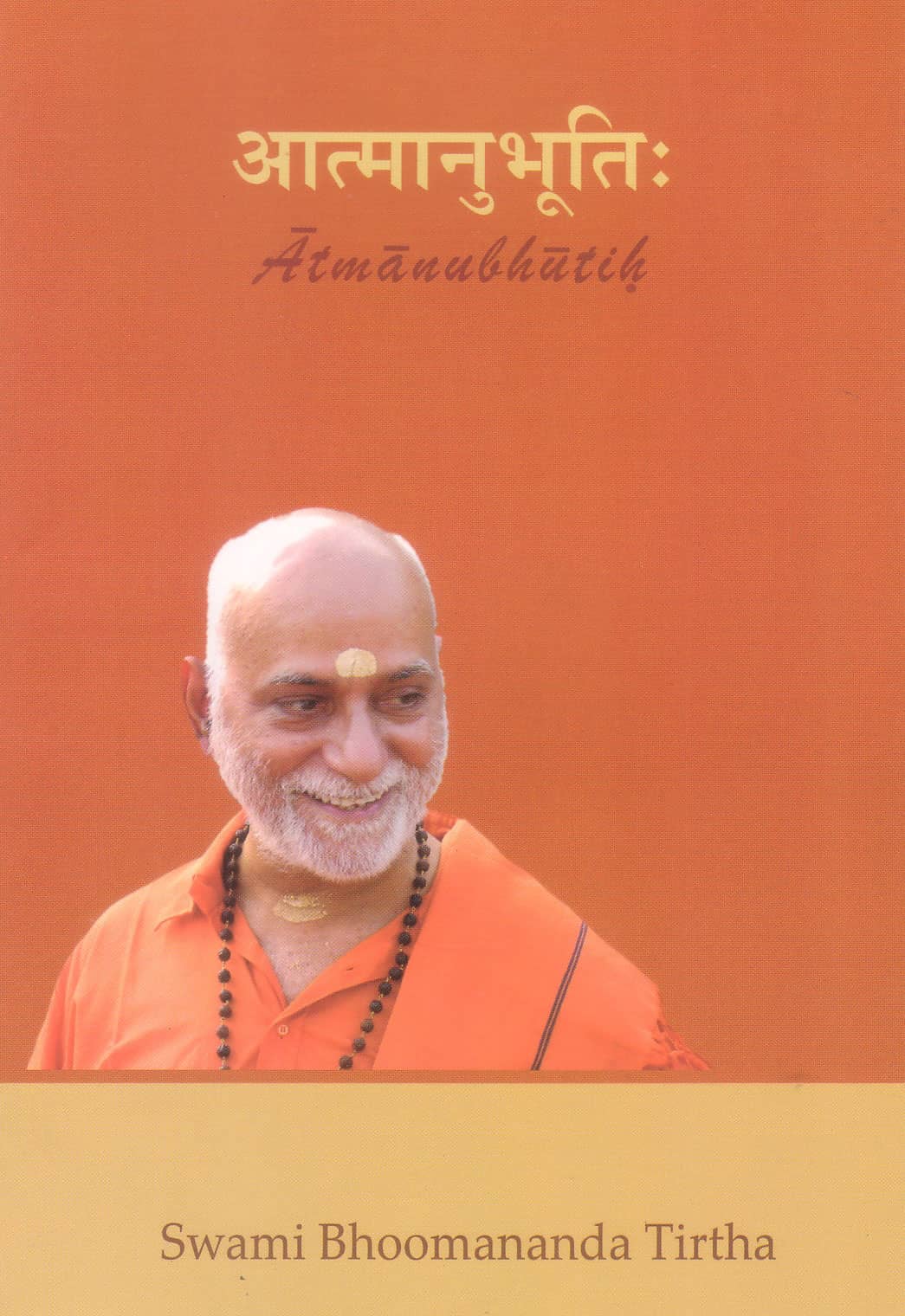Discourse & Satsangs
Gurupoornima Retreat 2024
START: JULY 23, 2024
08:00PM IST
END: JULY 28, 2024
09:30PM IST
VENUE:
Narayanashrama Tapovanam, Venginissery, P.O. Paralam, Thrissur District, Kerala - 680 563
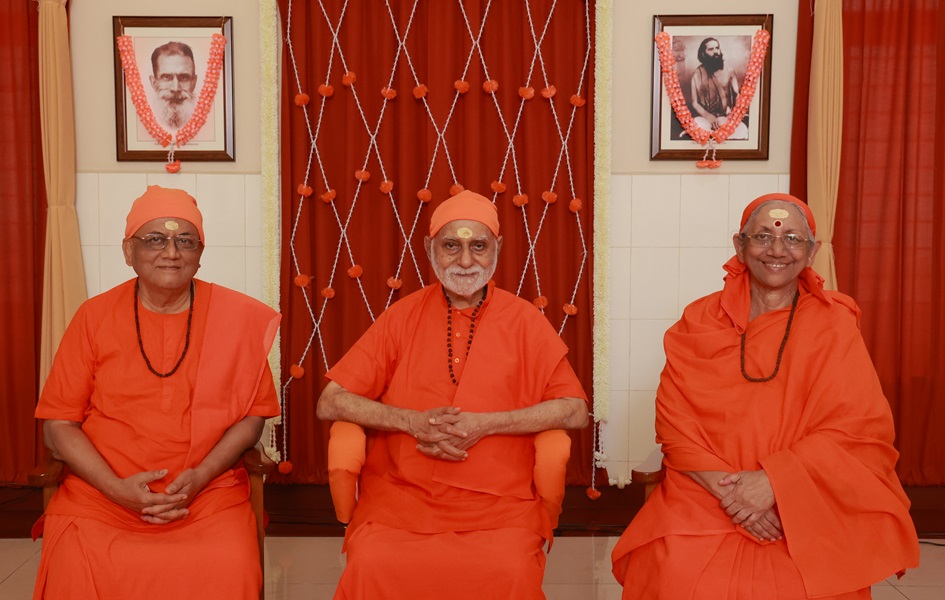
The Annual Gurupoornima Retreat was conducted from 23rd July to 28th July 2024, at Narayanashrama Tapovanam.
Gurupoornima Retreat Report
Tony Selden
First Impressions
My excitement was building up as the taxi from Cochin airport got closer to the Narayanashrama Tapovanam, following a 6-hour train journey from the North East of England to London, and from there a night flight to India. My first ever trip to the country was not as a tourist for sight-seeing, which holds little interest for me, but to gain first-hand exposure of the deepest truths of Life, discovered by the ancient Rishis of India in pre-historic times and handed down through the unbroken chain of Guru-paramparā, embodied by Poojya Swamiji, Nutan Swamiji and Ma Gurupriyaji.
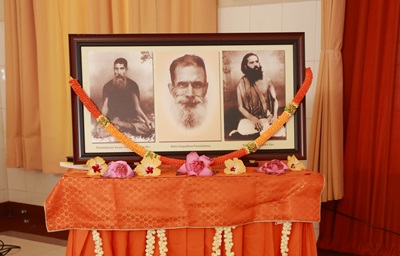 Guru Parampara
Guru ParamparaMy visit had been gestating for about 40 years after a brief but very significant real-life encounter with practical Brahmavidya in my early twenties. But I had only books as guides thereafter. Having discovered the website (Bhoomananda.org) five years back and since the Covid pandemic, become an avid remote participant in the online satsangs, I applied for attending the Retreat, and to my great joy my wish was granted.
The first impression of the Ashram was the beauty and order manifest there – a clear externalisation of the developed minds of the founding Mahatmas. Noticeable too was the very warm welcome I received on arrival from the Gurus, Ashramites, volunteers and co-seekers, another manifestation of the teachings of extending love unreservedly to all, transcending relatives and friends. The Ashram has clearly been developed with great respect to nature, with as many trees and plants as possible being preserved, planted and nurtured, along with a community of friendly animals too. All my apprehensions were thus quickly put aside, despite being the only attendee of European origin present for the event.
Retreat Orientation
On the first evening, a session was held in which all 3 Sannyasins gave some guidance on how the seekers should approach the Retreat. A Retreat gives the opportunity for a very deep and close association with the Guru. The Guru will attempt to inspire the seekers and answer any questions. Participants are supposed to introspect deeply on as well as discuss only spiritual topics with fellow seekers. It is a two-way conversation, such that the Guru will be able to transmit more if the seekers are attentive and serious in their quest, but also remain free and light-hearted. Intensity of such a rare event makes it a great opportunity
to make a leap in understanding as well as practice, doing sufficient introspection on our own and others’ behaviour.
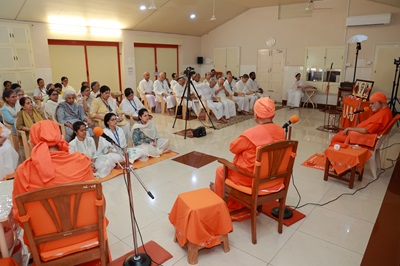 Poojya Swamiji’s Prabhāta-raśmiḥ every morning after Pushpa-samarpanam
Poojya Swamiji’s Prabhāta-raśmiḥ every morning after Pushpa-samarpanamPushpa-samarpanam and Prabhata-rashmih
I found a lot of significance in Pushpa-samarpanam ceremony, in which beautiful and fragrant flower-petals are carefully placed with deep gratitude and reverence at the feet of Poojya Swamiji, who has dedicated his life for transmitting the precious Brahmavidya. Prostration is made before Swami Nirvisheshananda Tirthaji and Ma Gurupriyaji also. The whole spell filled the devotees with joyful vibrations, although one like me brought up fully in a European culture initially felt a little uncomfortable. Sublimating one’s own ego and practising gratitude and devotion have their positive effect on the personality, no doubt!
During the following “morning rays of wisdom” sessions, Poojya Swamiji spoke very clearly about the necessity of both absorptional and interactional sadhana to gain full actualisation. During meditation of perhaps 30-60 minutes per day, we should calm all the mental and intellectual functions like memory, imagination, etc.. When I am practising meditation now, post-retreat, I can still hear Swamiji’s melodious voice gently repeating “thinner and thinner, lighter and lighter” as I approach the state of inner calmness, waiting for the substratum to reveal itself!
Another morning Poojya Swamiji clarified that we have to get to the stage of being able to apply our Self-knowledge and actualisation in a vibrant and perhaps challenging situation. This is a state of enrichment. An outside observer may not be able to appreciate the fullness of wisdom of a Jeevanmukta, a Sthita-dhee, who will always be full with contentment, with no delusional clinging, whatever be the circumstances he is in.
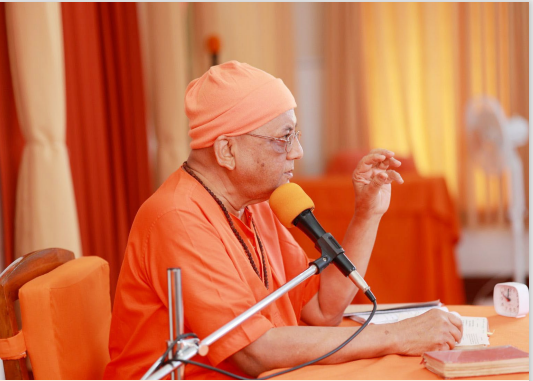 Nutan Swamiji's class
Nutan Swamiji's class“Remembering the Real I” – based on Viveka-cūḍāmaṇi
Nutan Swamiji’s Satsangs made an immediate impact in the very first session by his meaningful and melodious chanting of the 10 ślokas (verses 254 – 263) wherein Shankaracharya expands the theme of ‘Tat Tvam Asi’ – the Mahāvākya from Chandogya Upanishad. This set of 10 verses describes the transcendent nature of Brahman, which is different from both the manifest and unmanifest, creation and destruction, and indeed all dualities!
The last line of each of these ślokas “Brahma tat-tvam-asi bhāvayātmani” clearly appealed to everyone listening, as they spontaneously began chanting these before Swamiji arrived for each session. Swamiji explained word by word in considerable detail, dropping in his usual cross-references to Upanishadic ślokas and bringing relatable examples from physics, such as the nature of electricity, so that the meaning became very clear. The approach we have to take is initially to surrender and rise above our petty egoistic constraining thoughts and emotions. Ultimately, when we reach the transcendental Reality, there is no longer the question of surrender as we come to know that we are already surrendered!
Śloka Learning and Meaning – Group Work
Six teams were formed using the names of the 6 qualities that are listed in one of the Sadhana Catuṣṭayam – Śama, Dama, Titikṣā, Uparati, Śraddhā & Samādhāna – and each was given a śloka relating to the main Satsang themes. Each group was to learn to chant in unison and then explain the meaning on video, to be displayed during the review session on the final day of the Retreat. It was fun, but also taken very seriously by the groups, for whom it seemed to feel a bit like being back at school, every group wanting to do its best for impressing their teachers! At least there is now one śloka that I shall not forget so quickly!
“Bhakta Lakshanas – Who is a Devotee”
Where Bhakti & Jñāna Meet
Ma’s Satsangs were focused on the Bhakta Lakshanas – the qualities of a true devotee – starting with a fundamental examination of what devotion precisely means.
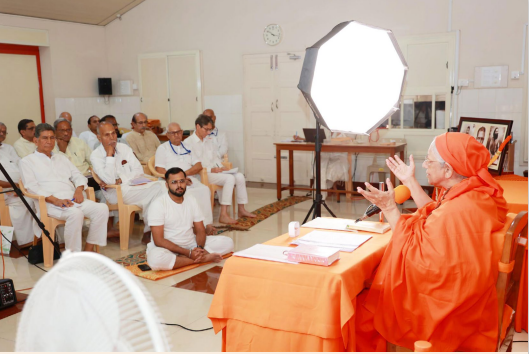 Participants engrossed during Ma’s classes on Bhakti
Participants engrossed during Ma’s classes on BhaktiIt usually begins in childhood as a form of worship of our often vague concept of an external higher being, to whom we pray for fulfilling our wishes, though we never get a direct answer! Whilst this does generate in the worshipper some sense of a wish to please that deity, it needs to be transcended – first by making such worship without any expectation of reward, then by expanding our understanding of God to an immanent and transcendent Presence, and ultimately realising that all living beings are God in the form of the Enlivening Indweller (Antarātmā).
We should develop one-pointed devotion to and full reliance on God, including radical acceptance of whatever, even if unpleasant, befalls us. By honest introspection, we should work on assimilating and thereby manifesting and actualizing the qualities of the Divine, as outlined in the Bhakta Lakshanas in Bhagavad Gita 12.13-20. “Read-Introspect-Repeat” is the motto for attaining these, making use of worldly interactions to self-examine in their light our own behaviour, and endeavour to correct the mistakes. Do not get deluded by your so-called devotion – neither hurt others nor get hurt by them in your fervent, but inattentive pursuit.
To name a few of the qualities: being ever-contented, kindly to all, forbearing, straightforward, impartial, even-minded, forgiving and living in the present. A person who has developed such qualities is declared as dear to Krishna. Thus,
we see that real devotion does not mean just doing pūjas, but becoming pure-hearted and pure-minded oneself!
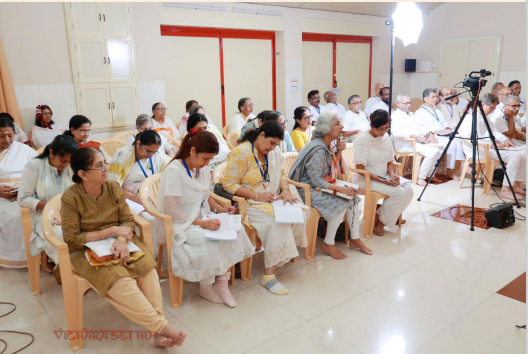
“Intertwining Gita’s Message into Daily Life”
Poojya Swamiji chose to expose the Bhagavad Gita in a special way that he has never presented before, despite over 60 years of Satsangs. So, we were especially blessed to be the first group to hear this approach. He chose specific ślokas that stand independent of any religious connotation and do not mention about God, Self, Soul or Brahman. In short, they are time-tested psychological help for dealing with daily life for all of us in the most effective and noble way.
This was further reinforced during another session of the series, in which Swamiji responded to a rather caustic comment received via the web, that his exposure had been akin to “the blind Swami leading blind followers”! Vedanta and Brahmavidya encourage the seeker to raise questions before the Guru in any manner. So, this was not a problem, though a more loving and refined enquirer would do this in a respectful and courteous manner!
The ślokas chosen expound (i) the teachings on the Real (permanent) versus the Unreal (changeable), (ii) rising above the alternating sukhas and duḥkhas with samatva bhāva, (iii) all visibles are an appearance in the mind, (iv) the unborn, undying and infinite substratum of Life, (v) the inner attitudinal enrichment of the Karma Yogi, (vi) the non-doer; the ability to assimilate any experience, (vii) non-possessiveness and (viii) dealing with attraction, repulsion and fear – to name a few of the main themes!
Especially memorable was the talk on sukha-duḥkha, in which Swamiji had us all laugh heartily at our own delusional desire to enjoy only sukha, as if that were ever possible!
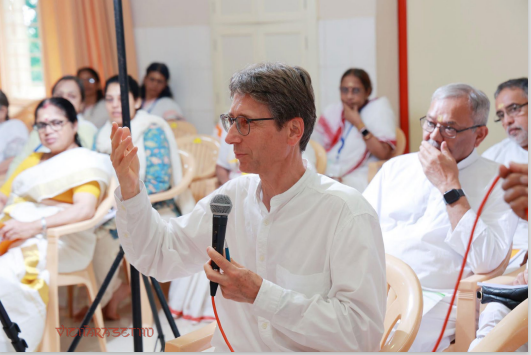
The Satsang that discussed the pentagon of 5 ślokas (4.19-23), which summarize the behaviour of a Knower with respect to action in the world, was also a new perspective to me. These have a particular resonance when chanted in sequence.
At the end of the series, Swamiji left us with the firm conviction that we can reach the state of the Supreme Identity in our experiential lives by cherishing and actualising this pinnacle of wisdom, as many have done before.
Concluding Thoughts
All in all, the set of discourses, exercises and interactions left me with a considerable enrichment and sufficient material to take home, re-study and make my own knowledge and realization steady and stable. I now have sufficient interesting ślokas to learn, to keep me going for quite a long time! It was definitely worth making the long journey to the unique abode of wisdom that Narayanashrama Tapovanam, under the guidance of the three Sannyasins, is – a rare jewel in this world, where there is currently so much delusion and unnecessary strife. So, I feel very blessed to have been able to take part in the Retreat.
Having presentations from the Ashramites and myriad workers who make this possible was also enlightening as to the scale of organization involved in the process. I would like to take this opportunity to thank them all heartily for keeping the place beautifully clean, keeping us wholesomely and deliciously fed, enabling the participants to be free to make the most of their precious time in Retreat in such a joyful inner and outer atmosphere.
In England there is a saying “Cleanliness is next to Godliness”, and that is certainly manifested in the Ashram! This being my first trip to India, I had my concerns about possibly becoming unwell, but I am happy to say that I remained healthy during my entire stay, surely owing to the aforementioned attention to detail all concerned showed in every aspect. Finally, hearing each seeker’s journey and state as they introduced themselves was also enlightening.
Until another time,
Om Śāntih Śāntih Śāntih! Jai Guru!
Our Guiding Lights
-
 Poojya Swami Bhoomananda Tirtha
Poojya Swami Bhoomananda Tirtha -
 Swami Nirviseshananda Tirtha
Swami Nirviseshananda Tirtha -
 Swamini Ma Gurupriya
Swamini Ma Gurupriya
ESSENTIAL READING/VIEWING

Swami Bhoomananda Tirtha
Glimpses of Arch Gate “Kavaata” Inauguration | Narayanashrama Tapovanam

Swami Bhoomananda Tirtha
Narayanashrama Tapovanam Arch Gate Inauguration Benedictory Address by Poojya Swamiji
“Come – Come – All Seekers of Truth” – Inauguration of the Arch Gate (28 July 2024)
[Upanishads as well as Śrīmad Bhāgavatam speak about announcing as widely as possible spiritual talks, programmes and institutions. It is not for fame, but to...
Read More
Be Endowed with Gurutva – Exalted Dimension
The word ‘Gurutva’ means profundity, solemnity, dignity and loftiness. In spiritual life, it implies the ability to receive, retain, and give. As one progresses, he must ultimately resemble the sky and God!
Read More
Swami Nirviseshananda Tirtha
Vivekachudamani – Discourse series by Swami Nirviseshananda Tirtha – Remembering the Real 'I'
EVENT SCHEDULE AND HIGHLIGHTS
| Date | Time | Program | Description |
|---|---|---|---|
| July 23, 2024 Tuesday | 8.00 pm - 9.15 pm IST | Discourses followed by Q/A | |
| July 24, 2024 Wednesday | 8.45 am - 10.15 am IST | Discourses & Q/A based on Vivekachudamani | |
| July 24, 2024 Wednesday | 10.30 am – 11.30 am IST | ||
| July 24, 2024 Wednesday | 4.00 pm – 5.15 pm IST | Discourses based on Bhagavad Gita, Sreemad Bhaagavatam | |
| July 24, 2024 Wednesday | 8.00 pm - 9.15 pm IST | Discourses & Q/A with Bhoomananda Tirtha ji | |
| July 25, 2024 Thursday | 8.45 am - 10.15 am IST | Discourses & Q/A based on Vivekachudamani | |
| July 25, 2024 Thursday | 10.30 am – 11.30 am IST | ||
| July 25, 2024 Thursday | 4.00 pm – 5.15 pm IST | Discourses based on Bhagavad Gita, Sreemad Bhaagavatam | |
| July 25, 2024 Thursday | 8.00 pm - 9.15 pm IST | Discourses & Q/A with Bhoomananda Tirtha ji | |
| July 26, 2024 Friday | 8.45 am - 10.15 am IST | Discourses & Q/A based on Vivekachudamani | |
| July 26, 2024 Friday | 10.30 am – 11.30 am IST | ||
| July 26, 2024 Friday | 4.00 pm – 5.15 pm IST | Discourses based on Bhagavad Gita, Sreemad Bhaagavatam | |
| July 26, 2024 Friday | 8.00 pm - 9.15 pm IST | Discourses & Q/A with Bhoomananda Tirtha ji | |
| July 27, 2024 Saturday | 8.45 am - 10.15 am IST | Discourses & Q/A based on Vivekachudamani | |
| July 27, 2024 Saturday | 10.30 am – 11.30 am IST | ||
| July 27, 2024 Saturday | 4.00 pm – 5.15 pm IST | Discourses based on Bhagavad Gita, Sreemad Bhaagavatam | |
| July 27, 2024 Saturday | 8.00 pm - 9.15 pm IST | Intertwining Gita’s message into your daily life | Discourses & Q/A with Bhoomananda Tirtha ji |
| July 28, 2024 Sunday | 8.45 am – 9.45 am IST | Remembering the Real 'I' (Concluding Session) | Discourses & Q/A based on Vivekachudamani |
| July 28, 2024 Sunday | 10.00 am – 10.45 am IST | Bhakta-lakshanas - Who is a Devotee (Concluding Session) | Discourses based on Bhagavad Gita, Sreemad Bhaagavatam |
| July 28, 2024 Sunday | 11.00 am – 12.00 pm IST | Pushpa Samarpanam & Prabhata Rashmih | |
| July 28, 2024 Sunday | 4.00 pm – 5.30 pm IST | Retreat Feedback | |
| July 28, 2024 Sunday | 8.00 pm - 9.15 pm IST | Intertwining Gita’s message into your daily life (Retreat Concluding Session) | Discourses & Q/A with Bhoomananda Tirtha ji |
Tuesday
Discourses followed by Q/A
Poojya Swami Bhoomananda Tirtha ji
Wednesday
Discourses & Q/A based on Vivekachudamani
Swami Nirviseshananda Tirtha ji
Wednesday
Wednesday
Discourses based on Bhagavad Gita, Sreemad Bhaagavatam
Swamini Ma Gurupriya ji
Wednesday
Discourses & Q/A with Bhoomananda Tirtha ji
Thursday
Discourses & Q/A based on Vivekachudamani
Swami Nirviseshananda Tirtha ji
Thursday
Thursday
Discourses based on Bhagavad Gita, Sreemad Bhaagavatam
Swamini Ma Gurupriya ji
Thursday
Discourses & Q/A with Bhoomananda Tirtha ji
Friday
Discourses & Q/A based on Vivekachudamani
Swami Nirviseshananda Tirtha ji
Friday
Friday
Discourses based on Bhagavad Gita, Sreemad Bhaagavatam
Swamini Ma Gurupriya ji
Friday
Discourses & Q/A with Bhoomananda Tirtha ji
Saturday
Discourses & Q/A based on Vivekachudamani
Swami Nirviseshananda Tirtha ji
Saturday
Saturday
Discourses based on Bhagavad Gita, Sreemad Bhaagavatam
Swamini Ma Gurupriya ji
Saturday
Discourses & Q/A with Bhoomananda Tirtha ji
Sunday
Discourses & Q/A based on Vivekachudamani
Swami Nirviseshananda Tirtha ji
Sunday
Discourses based on Bhagavad Gita, Sreemad Bhaagavatam
Swamini Ma Gurupriya ji
Sunday
Sunday
Sunday
Discourses & Q/A with Bhoomananda Tirtha ji




